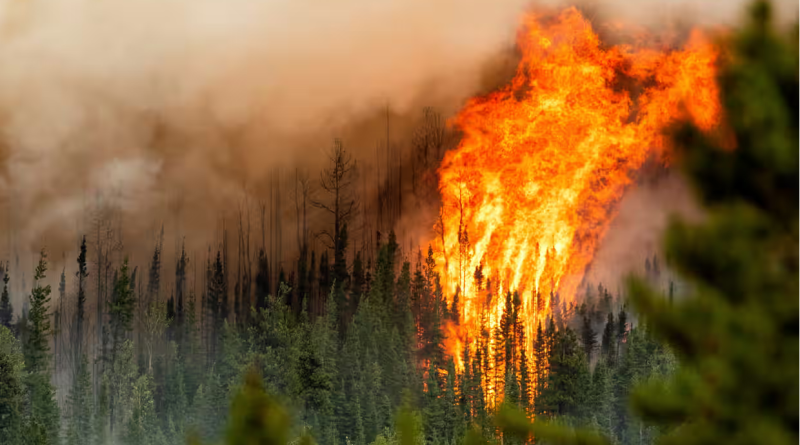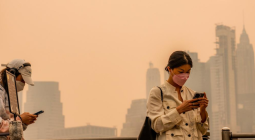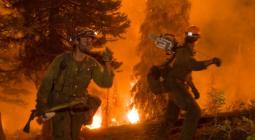Canada’s 2023 wildfires produced nearly a decade’s worth of blaze emissions

Canada’s “record-shattering” wildfires last year produced nearly as much greenhouse gas emissions in one season as would be expected over a decade of fires in normal circumstances, data has shown.
The fires, in Canada’s “wildest season ever”, were made at least three times more likely by the climate crisis, and produced about 2bn tonnes of CO2, about a quarter of the total global emissions from wildfires last year, according to data in the State of Wildfires report, published on Wednesday.
The health impacts from last year’s fires will also continue to be felt for decades.
Carbon dioxide from wildfires is a growing source of greenhouse gas emissions globally, reaching about 8.6bn tonnes last year, considerably more than the 4.8bn annual emissions of the US from all sources. However, the net impact of fires is likely to be reduced by the regrowth of vegetation taking up carbon from the atmosphere.
Matthew Jones, a research fellow at the Tyndall Centre for Climate Change Research at the University of East Anglia, and lead author of the report, warned that damage from intensifying wildfires would continue to increase unless the world succeeded in bringing down greenhouse gas emissions. Wildfires not only kill people, wildlife and livestock, and devastate trees and other landscapes, but can cause widespread and dangerous air pollution.
They are also an increasingly important contributor to the climate crisis, through their greenhouse gas emissions and destruction of carbon stored in vegetation and soil.
“These fires are something we should all be concerned about,” he said. “The full effects of last year’s fires will not be seen for a long time.”
Canada’s fires, with a burned area that was six times greater than the average year, were some of last year’s worst. Brazil’s Amazonas state also had record highs, owing to a severe drought, while fires in Hawaii and Texas killed more than 100 people. The biggest single fire ever recorded in the EU burned 900 sq km of Greece.
However, lower than usual levels of burning in African savannah meant the greenhouse gas emissions from wildfires last year were only 16% above average – if savannahs had burned at their usual rate, rather than experiencing such relative calm, last year would have set a new record.
Separate data from the World Resources Institute showed that in 2023 nearly 12m hectares were burned by forest fires, an area roughly the size of Nicaragua, which was about a quarter more than the previous record in 2016. Between 2001 and 2023, the area burned has increased by about 5.4% a year, with the result that forest fires now result in nearly 6m more hectares of tree cover loss a year than they did in 2001 – an area roughly the size of Croatia.
Fires require not just high temperatures, but also an abundance of dry vegetation, and some form of ignition – either human or natural – to start and to continue burning fiercely. Cutting greenhouse gas emissions must be the biggest priority to prevent more wildfires in future, the authors said, but better land management and early warning systems could also help.
Banning people from setting fires, creating fire breaks and boundaries, and managing agricultural and forested areas in such a way as to reduce the amount of dry brush that provides fuel for fires, are also important. Providing masks and ventilation can also reduce the air pollution impact.
Early warning systems can be limited, however – in many hot areas there is a high likelihood of fire for most of the summer season.
“Wildfires are becoming more frequent and intense as the climate warms, and both society and the environment are suffering from the consequences,” said Jones.
Although wildfires occur naturally in many of the world’s hot regions, the effects of the climate crisis on their frequency and severity are now clear, according to the report. Human-driven changes to the climate made fires three times more likely in Canada, 20 times more likely in western Amazonia, and twice as likely in Greece.
As greenhouse gas emissions continue to mount, bigger fires can be expected. The researchers found that a Canadian born today would be more likely than not to experience another fire of similar magnitude to last year’s inferno within their lifetime, compared with a one in 10 chance of seeing such a fire for someone born in the 1940s.
Even wetlands and moist rainforests are now at high risk of fire, as unprecedented drought has taken hold. Brazil’s Pantanal region was devastated in June by record-breaking fires, which laid waste to globally important wildlife habitats.
Although regrowing forests can absorb carbon dioxide from the air as they develop – creating a “delayed carbon sink” – the shifts to more frequent fires are creating a worrying trend, where vegetation has less chance to recover, Jones added. This is making fires an increasing source of carbon in the atmosphere.
“The real problem begins when you have a shift in the fire regime away from its natural state and towards more frequent and severe burning. Unfortunately, that’s exactly what we’re seeing in forests, and it’s resulting in an imbalance – immediate emissions from forest fires this decade are increasingly outweighing the delayed sinks from fires in previous decades,” he said.
The State of Wildfires report 2023-24, published in the journal Earth System Science Data, was led by the University of East Anglia, the UK Centre for Ecology and Hydrology, and the Met Office, with the help of a broad network of researchers and institutions around the world. Scientists used global satellite observations, computer models and research from regional experts to compile the data.





